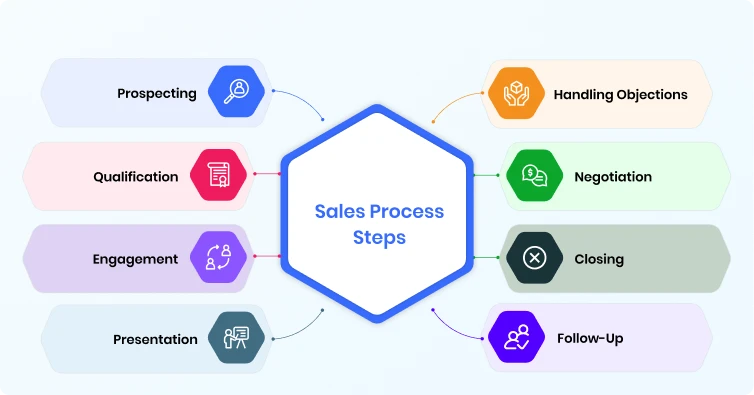The 7-Step Sales Process: A Guide to Closing More Deals
- April 16, 2024
- 29 mins read
- Listen

- Having an experienced sales team is often the key to increasing the sales of your products.
- It’s the efforts and creativity of your sales team that are responsible for converting prospects into happy and paying customers.
What is a Sales Process?
The sales process is a defined series of steps to convert prospects into paying customers. It acts as a detailed guide for sales teams to close and convert a deal. The sales process is also a structured framework for increasing sales efficiency and improving profit margins. It has different stages that provide a direction to the sales team to move prospects. In addition, this process ensures a systematic approach to closing deals by effectively meeting customer needs. There are well-defined steps in the sales process that help sales teams understand how to keep customer relationships strong and alive.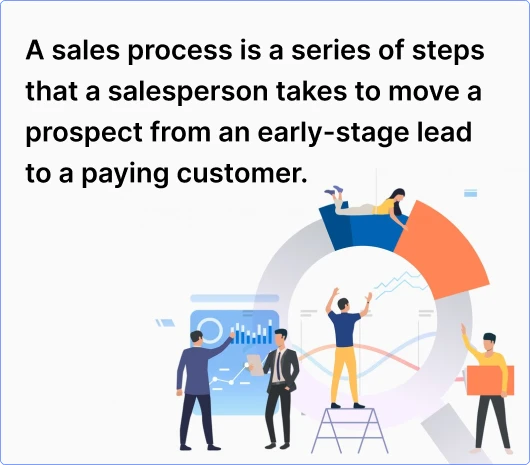
Key Characteristics of an Effective Sales Process
- Defined and Documented – An ideal sales process has clearly defined and documented stages. It has everything well-defined – what happens during each phase, what buyer behavior to expect at each stage, and the milestones to aim for each stage.
- Customer-Centric – A good selling process will always have customers at the heart of everything. The framework it uses will have the needs, pain points, preferences, wants, and behaviors of the customers you want to target.
- Flexible and Dynamic – Salespeople may suffer when the selling framework is rigid and does not give them the freedom to try things out of the box. When the selling process is flexible and dynamic, it gives salespeople wiggle room to deal with prospects in complex situations and offer the right solutions.
- Clear and actionable – All stakeholders should clearly understand each stage and element of the sales process. If the process has well-defined and actionable actions, it will reduce the chances of confusion and errors by sales teams.
- Measurable and Goal-oriented – The purpose of having a sales framework is to guide the sales team on how they can achieve the goals expected of them. It should help you measure all the actions and activities of the sales teams to achieve improvement.
- Scalable – The selling guideline your sales team uses must be scalable to accommodate the future growth of your business. A scalable process is essential to replicate the results if there are more prospects to handle at any point in the future.
- Value Addition for the Stakeholders – The selling process you use must be a value addition for key stakeholders, i.e. sales teams and prospects. It must be easy to adapt for sales reps and also help prospects with their decision-making process.
- Easy to Modify – The process you use for selling must be easy to modify as the sales environment is dynamic and it keeps changing over time. Make sure the process can be easily modified based on the new information, buyer patterns, and new tech advancements.
- Efficient – The sales process must be efficient to help you achieve seamless integration between your sales and marketing departments. It should add elements of automation for various repeatable processes as well. Above all, it should add a collaborative environment within your sales teams to make the selling process more effective.
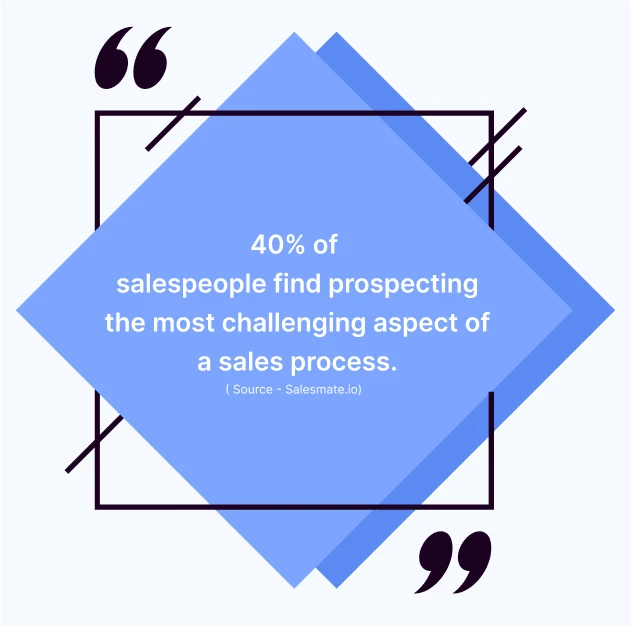
Why Build a Sales Process?
Sales is a challenging job. Challenges multiply when the sales team has no framework to work with. This limits their effectiveness to a great extent. With no guidance to follow, sales reps may have to rely on experience to convert prospects into customers. What if a business does not have an experienced and adept sales team? It will have to face missed opportunities. Not having a proper framework for selling means sales reps are not sure what exact process to follow. It becomes like shooting in the dark. When there is no sales process –- Sales reps lack a standard approach to selling
- They are clueless about what to do next
- They are not able to track metrics and improve mistakes
- Understand the importance of sales processes
- Know how to close deals successfully
- Ensure that a structured approach is followed in converting prospects
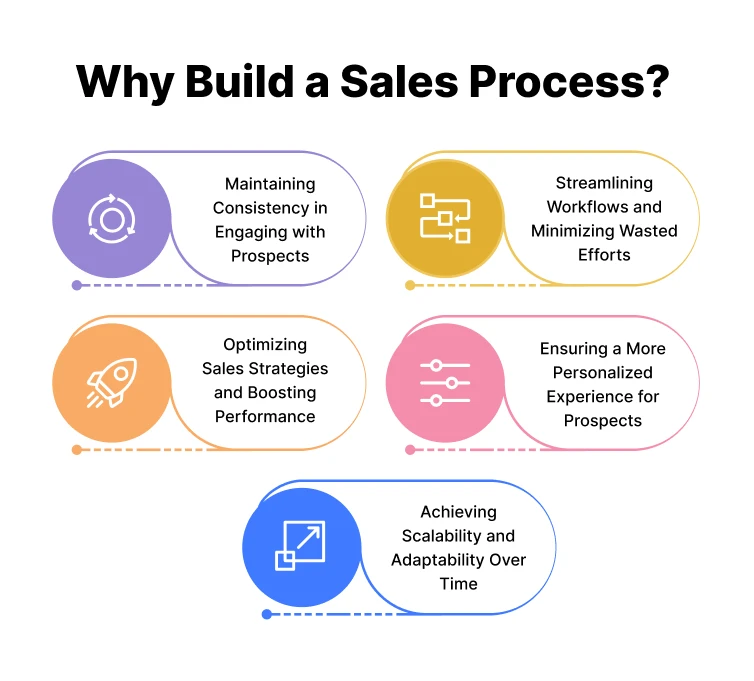
Why is a Sales Process Important for Your Sales Team?
A sales team performs better and achieves more when it has a proper guideline to follow. When the process is already defined, sales reps tend to close deals more successfully. There are more reasons why a process is important for the sales team, including – Make the Sales Hassle-Free – Sales can be complicated if done without a clear roadmap. It can lead to wasted efforts and missed opportunities. Salespeople however can perform better when then there are well-defined rules to follow. It will help them understand every aspect throughout the sales journey – starting from the prospecting to the conversion and beyond. A clear process for sales helps the sales team understand where the buyers are in the sales cycle and what they expect. Ease of Tracking Performance – Most businesses that don’t have a proper sales structure in place fail to understand what went wrong and where. They can also not track anything beyond the total number of deals closed and their value. On the other hand, following a selling process means you can track and measure your sales team’s performance at every stage of the sales cycle. Better Understanding of Prospects – Salespeople whofollow a defined process add great value to not only sales teams but also to prospects. They often research a lot about prospects, try to understand their prospects and their needs better, and take steps to meet those needs. More so, the sales team that follows a structured approach will often outline buyer personas and customer profiles before approaching prospects directly. This increases the chances of conversion as well. Identify Risks and Opportunities – Following a standard process for selling ensures that sales efforts go in the right direction. It is also helpful for quickly identifying risks and opportunities and doing away with the activities that are least likely to add desired sales value. When the sales team follows the process, they easily know the reasons why deals get stuck, or what prospects exactly need at each stage of the buying cycle. Facilitate Smooth Onboarding – Coaching and training new sales reps is easier when there is already a guideline in place for selling. It also helps less experienced reps quickly get through the tricks of the trade and understand how the sales things work at your organization. Sales managers can use the process to teach reps about what they need to do at each stage in a sales cycle. More Clarity on Revenue Generation – A certain degree of predictability is essential for revenue generation. Having an accurate view of the revenue at the end of a sales cycle can prepare a business better to deal with operational challenges. Establishing a sales framework means you can keep track of the prospects in your pipeline at any point in time, resulting in a clearer view of the expected revenue for the specific sales period. Accommodate Customer Experience – Salespeople are always eager, sometimes impulsive, and forever ultra-excited to close deals. This attitude often does not sit well with those prospects who take time to move through the sales funnel and may not be ready for the next step yet. Sometimes this eagerness may cause the deal to drop. Such problems don’t happen when sales reps follow a proper process as then they understand the buying steps and also keep the process aligned with buyer needs and behavior.The 7-Step Sales Process
1. Prospecting
“40% of salespeople find prospecting the most challenging aspect of a sales process. ( Source – Salesmate.io) Prospecting is the first step in the sales process. It involves finding new leads or prospects for the business. This step is very important as it sets the tone for the rest of the steps of the process. At this stage, you need to determine whether your potential client has a particular need that you can fulfill. Among other things, you may also need to establish whether the prospect can afford what you offer. In the prospecting stage, you will need in-depth research to identify your ideal customer. Once the potential leads are identified, you can compile a list and then screen them based on qualifying questions. At this stage, you can –- Create buyer personas and ideal customer profiles based on the customers who have already done business with you in the past
- You can use the past data to understand the challenges your customers face and present your product as the best fit for their needs
- You can use online tools such as emails and social media outreach for prospecting
- You may also use offline tools such as cold calling, industry events, and trade expos to connect with prospects
- You may also encourage existing customers for referrals
2. Qualifying
“67% of sales are lost due to sales reps not properly qualifying their potential customers. ( Source – Business2Community.Com).The qualification stage is the next step in the sales process where your focus will be on discovering more about prospects through qualifying questions. It will also be the first time or step when your reps make direct contact with a potential client. The purpose of connecting with the lead is to find out whether they are an ideal suit for your product or service. In the qualification stage, you should rely on the BANT framework ( Budget, Authority, Need, and Timelines) and determine four key things – Need– Does the lead want what you offer Budget – Does the lead have the resources or money to buy what you offer Authority – Does the lead have the decision-making power to buy from you Timeline – Does the lead have a specific timeline in mind to buy from you soon Apart from using the above qualification questions, you’d certainly want to dig deeper and understand your potential clients better. There’s plenty more you can research about the prospect, including –- Check their website, blog, and social media pages, and try to read reviews about their products across channels
- Learn more about their customers or target audience
- Prepare a list of more questions if the basic ones don’t offer much information about leads
- Analyze the strengths and weaknesses of the clients as it will help you target them better
3. Developing Personal Relationships
Selling is not easy in today’s competitive market. If you want to sell, you first need to form a connection with customers. Forming a connection means you need to get leads emotionally connected with your story, brand, or offer. This can’t happen unless you build personal relationships with your leads. The more you get leads emotionally invested, the better chances of conversion you will have. The key is to find ways to offer value to them that fixes their pain points. It’s also about developing a personal rapport and treating them like friends. To develop relationships with leads, you can consider –- Contacting leads personally in a professional manner and tell them what you offer
- Sending them excluding offers through personalized emails
- Discussing with them how your business can help them
4. Presentation
Presentation is a very important step of the sales process where you will display the unique value of your product. The quality of the presentation will be a big determinant in influencing a buying decision, and also a key factor in nurturing leads. This step is also important because it gives you a chance to present your product as a best-fit solution for your clients. This is why the presentation step comes after you have already understood the problems and needs of the leads. Presentation is also the step where you get to showcase or prove your product’s USPs and capabilities. You can either give a demo or show the product sample to prospects and corroborate your claims of excellence. Key things to consider in this stage –- Always approach the presentation step after having analyzed the competitors and their offers, as it will help you present your product as a better option for leads
- Treat the presentation as your last chance to show prospects how your product can help them overcome the issues they face
- Make a list of all the strong points of your products and discuss them
- Show evidence so that your claims don’t feel lofty and bogus to clients
- Keep the presentation aligned with the buying motivation and keep it to the point
5. Objection Handling
It’s natural for prospects to have questions and concerns about your products. There could be plenty of reasons why a potential lead would hesitate to commit despite an interest in your offers. Pricing and timing are two key reasons why most prospects feel hesitant to go ahead with the purchase. There may be other concerns as well, but they are not as dominant as pricing and timing. Well, whatever reasons or objections a prospect has, the sales rep has to address all of them in a detailed manner. If the rep can successfully handle all the objections, it will remove the fears from the minds of prospects, improving the chances of conversion. Some common objections that prospects may raise –- We have better options available in the market at a lower price, so why should we choose you?
- Your offer looks on the higher side of the budget we have set. Can you reconsider the cost as we need an economical option?
- We doubt how your offering can be the right fit for our problem.
6. Closing the Deal
This is the stage every sales rep hopes to reach and cross with flying colors. However, this is also the stage where a deal is made or broken, depending on how reps have handled the objections and understood the prospect’s concerns. Closing the deal happens only after the rep has successfully convinced the prospect that their offering can meet their needs. Before moving ahead, it’s important to ask the prospect two things – If they fully understand the terms of the sales, and whether they are ready to buy. Closing a deal often involves a lot of activities, including –- Drafting a proposal
- Negotiating terms or pricing
- Signing contracts
- Allying additional objections
- Completing a monetary transaction
7. Nurturing
Closing the deal is not the end of your sales process. Rather, you need to focus on nurturing the relationship with the client as it will help you generate new business opportunities and minimize churn. When you invest time and energy in nurturing relationships with clients, you end up having happy customers who are considered the most valuable asset a business can have. The same happy and nurtured customers can be a source of new customers through qualified referrals. So, you should continue to communicate and reinforce value to customers. This will offer you opportunities to upsell and cross-sell.How to Improve Your Sales Process?
1. Audit Your Current Sales Process
If you want to improve your sales process, the first question you should ask yourself – why am I doing that? You will get the answer which will be something like that – because I want to know what isn’t working and what I need to change to make it better for sales reps. Key things you should consider –- Analyze the existing selling process and identify gaps
- Evaluate some of your recent deals and try to get a pattern
- Understand the time your entire process took with previous deals
- Find out bottlenecks at each customer touchpoint
2. Analyze Your Persona’s Buyer Journey
Understanding your persona’s buyer journey can help you rectify the errors and mistakes in your sales process. You can make effective changes to your selling process only when you know how your ideal customer progresses through the different stages and ultimately buys from you. You can make your sales framework more focused and effective when you know what drives your ideal buyer to purchase from you and why your solution may appeal to them. Based on that analysis, you can also grasp many key information like –- How your ideal customer would like to be contacted
- What kind of messages they are going to be most receptive to
- What are the common problems they face during the purchase journey
- What motivations they will have in actually buying from you
3. Look at Your Processes from the Buyer’s Perspective
Since you want to improve your sales process, before doing that, you should ask – is the existing one designed from the buyer’s perspective? The answer should be yes only if your current process aligns with your prospect’s buying journey. More importantly, your sales framework needs to accommodate the potential challenges and motivations of your ideal customer. Based on this information, you can provide your sales team with the right tools and resources to establish strong bonds with prospects and present your offers to suit their needs.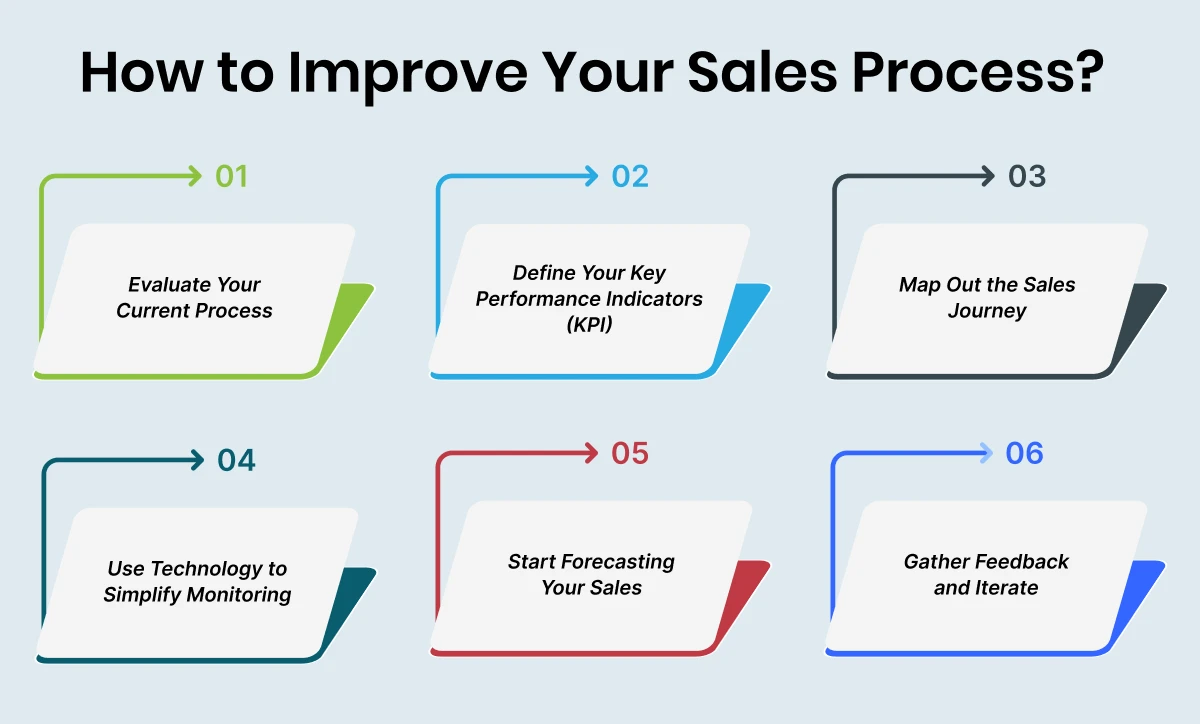
4. Check If Your Sales Reps Have Right Information for Each Step
Sometimes how sales reps deal with prospects at each step defines the fate of a deal. If the rep is experienced and aware of the information and content that drive leads, your chances of conversion remain high. On the other hand, if the rep lacks knowledge of how to move prospects to close, the deal might get stuck. This is why you need to check if each of your reps uses standard information and content at each stage of the buying cycle. Key strategies you should consider –- Make sure your reps are equipped with the information and processes they need to follow when they contact a prospect
- Make sure all of your reps fully understand the actions they need to take at each step of the sales process
- Ensure that your sales team has a standard approach to engaging with prospects, at least in terms of the specific types of content they share during each stage and the procedures they follow appropriate for each stage
5. Consistently Measure the Results
“If you don’t measure, you can’t improve.” Consistently measuring the results of your existing sales process is the key to improving it. By measuring the result, you will grasp where your sales team is doing right and where it needs to improve. In addition, only when you measure the results of your selling process will you be able to understand whether your team’s efforts match the business objective. You can use many metrics for tracking and measuring the results of your sales performance and it’s up to you to decide which ones to use.Sales Process Mapping
Sales process mapping is a visual representation that outlines the various steps, activities, and stages involved in a company’s sales process. It’s a diagram that gives a structured and step-by-step view of how a sale progresses from the initial stage to the purchase point. Sales process mapping is done using visual tools such as flowcharts or diagrams so that sales teams can easily understand the entire process and follow the steps. In short, this mapping is a method for visually analyzing and representing the sales process with a focus on optimizing sales operations.How Does Sales Process Mapping Work?
Step 1: Understand and Document Each Step of the Current Process – Understanding the existing process is the first step in sales process mapping. Based on that, each step is documented with a clear mention of who is responsible for each task, the key milestones, and the tools to be used at each stage. Step 2: Create a Visual Representation A clear map of the sales process is created using flowcharts, diagrams, or other visual tools. This is done to help everyone easily identify inefficiencies, redundancies, and bottlenecks in the existing process. Step 3: Analysis of Strengths and Weaknesses Once the visual representation is done, the next step is to analyze it for strengths and weaknesses. The focus will be on identifying the areas where the sales team might face challenges, or prospects might get stuck. Step 4: Integrate Metrics and Data Each stage of the selling process can decide the fate of a deal. It’s therefore important to integrate metrics and data into your map and measure the performance of each stage. Step 5: Continuous ImprovementThe sales process is key to improving sales operations by identifying areas of concern. The mapping can standardize the sales framework across the organization and let you track KPIs at each stage. You can also use the mapping to train and onboard new sales members. Step 6: Monitor and Evaluate Now when the mapping is done, you can implement changes and then keep track of those changes. You can thus update the map accordingly as and when opportunities for improvement arise.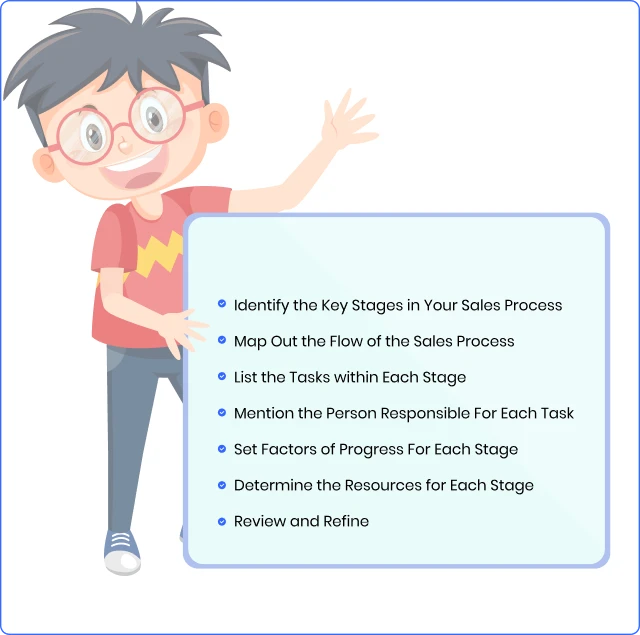
5 Things to Consider for Building a Successful Sales Process
1. Learn from Your Past Sales
Past sales are always a great tool to learn a lot about prospects and what led them to convert. When you analyze your past deals, you will understand what worked for your team and what did not. You will learn about the factors that contributed the most to a deal to progress. Analyzing past sales will help you –- Find patterns in behaviors of converted and missed customers
- Understand the exact reasons that caused the deal or that deterred the deal
- Realize the key features and timing that work best with customers
2. Set Clear Goals
A sales process works effectively when you have set goals for each step. If goals are not set, the sales team might feel confused and lack the direction to follow. Defining the metric for each stage and setting the benchmarks can help you stay on the right track all the time. Take for example, if your business is more concerned about losing customers, you can then set a target of reducing churn rate by 20% for a specific period, or something like that. With that kind of specific goal in mind, your sales team can take each step accordingly and add value to your cause.3. Create a List of Actions for Each Step
Sometimes, a wrong action at a crucial step might make the deal slip through the crack. This happens with the best of salespeople. To avoid that, you should create a list of specific actions for each step so that your sales team knows what to do and when. With clear actions for each step, there won’t be any hiccups in your sales cycle and your sales reps can easily move potential leads from one step to another in a convincing manner.4. Evaluate Your Buyer Persona
A successful sale is as much about a sales team’s effort as it’s about a prospect’s intention to buy. If the prospect is not ready to buy, even the most skilled of sales reps can’t do much. It’s therefore important for you to evaluate your buyer persona so that you can better understand your customer’s actions and reactions to your sales framework. When you evaluate your buyer persona, it means you’re ready to make your sales customer-centric. You can also identify where your team is facing difficulty in meeting customer needs and how to improve on that.5. Define Your Key Performance Indicators (KPI)
Defining your KPIs is always essential as it will help you track and measure the performance against the objectives. It will help you understand how effectively your sales team is achieving its goals. Most importantly, you can use your business-specific KPIs at different stages of the sales process to track the progress, or lack of it at any point in time.What is a Sales Process Flowchart?
A sales process flowchart is a document that visually depicts the key steps in the business process, from prospecting to closing deals. It’s created to serve as a guide and assist salespeople in identifying and isolating problems in the process. Using the flowchart, sales reps can improve efficiency and reduce waste from their selling process. Most importantly, its creation paves the way for optimizing and organizing your sales activities. Sales managers make use of the flow chart to let every member understand their roles and duties for each stage. This flowchart can help you boost your sales operations. Benefits of using a sales process flowchart –- Increase the overall efficiency of the sales process
- Get clarity of procedures and actions required to execute a sale
- Improve the effectiveness, performance, and productivity of sales reps
- Train new sales reps and quickly explain to them the value of each stage
H2 – Sales Process vs Sales Methodology: Key Differences
| Sales Process | Sales Methodology |
|
Series of repeatable steps to guide the prospect to the customer |
Strategy to execute each step of the sales process |
| Outlines actions to complete a sale | Outlines strategy to engage with customers |
| Defines the “what” of selling | Defines the “how” of selling |
| Provides a standardized approach across an organization | Provides a situation-based flexibility to salespeople |
| Rigid with defined steps | Adaptable based on real-time feedback |
5 Popular Sales Methodologies
1. Sandler Sales Method
It’s a popular sales methodology with a main tenet that says that the seller should always work to raise and overcome the objections of buyers throughout the sales process. The main idea of the Sandler Selling System is to understand the possible objections of prospects as early as possible and filter out poor-fit leads.2. Target Account Selling
It’s another popular sales methodology with a main tenet that advises picking the right prospects at the very beginning and knowing very early whom to engage with. The main idea of this methodology is to continue prioritizing at each stage and understand whether an opportunity is worth pursuing.3. Value Selling
This methodology is popular for its main tenet of focusing more on value rather than product or service. It dwells on selling value rather than what you offer as people don’t buy products; they rather buy the results of what you offer.4. Conceptual Selling
This methodology is based on the premise that buyers don’t buy a product or service; they rather buy the concept of the solution provided by the offer. It encourages sellers to attentively listen and then ask the right questions to buyers to better understand the concept they are looking for.5. N.E.A.T.
This sales methodology is an updated version of other methods like BANT and ANUM. Like them, it’s also best suited for the qualification stage. As the name suggests, the four core areas of focus of this methodology include – Need – Identify the needs of your target audience Economic Impact – Tell prospects the economic impact of your solution compared to their existing oneAccess to Authority – Identify and engage with the people who make decisionsTimeline – Set a timeline that is suitable for both the involved partiesCommon Sales Process Mistakes
Sales is not as easy as it may sound on the surface. It has a detailed process for converting prospects. This process however is dynamic and may change or evolve. It’s also prone to mistakes, including –- Lack of Clarity in Steps – Moving prospects through each stage of the process is easy when there are clear actions defined and documented for the sales team. However, when these actions are not clearly defined, sales reps may look less assured in handling prospects. This might negatively impact the conversion rate.
- Undocumented Sales Learning – Sales is a dynamic concept. Every prospect behaves differently and requires tweaking of the approach to get converted. What works with one prospect may not work with another, and so on. It’s therefore important to document every sales learning so that the learning can be used to improve your existing selling process.
- Rigidity with One Approach and Methodology – Buyer behaviors and preferences keep changing over time. So, chances are high that the methodology that has worked so far may fail to yield results. This is why sticking with a particular sales method, methodology or process is not good as you should try to evolve with time.
- Not Measuring the Success of Your Process – Many sales managers make the mistake of not tracking and measuring the success of their sales approaches. This can prevent them from identifying any shortcomings that may creep into the process and affect sales performance.
- No Alignment Between the Stages and Steps – Sales performance improves considerably when the sales team follows the required actions at each stage of the buying cycle. However, many a time, there could be a lack of alignment between the steps and the stages, resulting in failed conversion.
- Less Focus on Value, More on Deals – Most sales teams make this common sales process mistake – they focus more on deals and ignore value. This approach means your sales framework is less customer-centric and more focused on profits. The easiest way to avoid this mistake is to make provisions in your process for delivering value at each stage.
Sales Process Example
1. Sales Process of a B2B Company
- The company got a lead. After that, the sales team found the contact details of the decision-maker and established a contact.
- The sales team managed to get the approval to present a product demo.
- The company offered a trial period to the prospect. During the trial period, the sales team stayed in touch with the lead and whenever possible re-emphasized the value of the service
- After the trial period, the prospect agreed to proceed with the deal.
- The approval process involved other decision-makers in the company.
- The approval happened and the deal was closed.
- After closing the deal, the sales team followed up with the client to check if everything was going ahead as smoothly as promised. During the follow-up stage, the focus was also on prospecting the product to other departments or branches of the same organization. Soon, referrals happened and prospecting commenced again for those companies.
2. Sales Process of REVE Chat
REVE Chat is a popular SaaS company whose omnichannel customer engagement platform helps businesses delight customers and boost sales with Live Chat & AI Chatbot. Let’s understand the sales process used by this company.- The company got leads.
- Once leads are captured, the sales team reaches out to prospects through calls or personalized email messages.
- The sales team connects with the leads to understand their pain points and challenges. This follows a product demo stage to show how its product can be the right fit for the client’s requirements.
- The next step is to offer a free trial of the REVE software for 14 days to let prospects experience and understand the features in detail.
- Prospects are contacted again during the trial period. This is done to understand objections and provide technical assistance if needed.
- After that, both the parties, i.e. REVE Chat and the Prospect, enter into a negotiation over pricing, terms of the contract, and other key aspects.
- Now the proposal is ready and it’s presented to the client for review. Once the review is done, the contract is formally signed. Immediately after that, the onboarding process starts.
- The product is set up and integrated with the systems in the same way as mentioned in the contract. The client is properly trained on the software.
- The company then ensures ongoing support to the client through various channels. It routinely reaches out to the client to check if everything runs smoothly at their end.
Final Thoughts
Creating and mapping a sales process is vital for helping the sales team close more deals. It also helps them enhance every prospect’s experience with the brand. At REVE, we understand the value of engagement in creating an effective sales process for your business. That’s why we offer a variety of tools to effectively engage and interact with your audience. With us, you can sign up and check how our tools can add value to your sales process.Frequently Asked Questions ( FAQs)
What is the Sales Process?
The sales process is a structured framework or guideline that sales reps follow to move a prospect from an early-stage lead to a paying customer.What are the 7 Steps in a Sales Process?
The seven steps in a sales process include –- Prospecting
- Qualifying
- Developing Personal Relationships
- Presentation
- Objection Handling
- Closing the Deal
- Nurturing
What is the Difference Between the Sales Funnel and the Sales Process?
The sales process conveys the actions or steps salespeople take to convert prospects into customers whereas the sales funnel coveys what potential customers might do next.What is the key Difference Between the Sales Process and Sales Methodology?
The sales process outlines the actions to complete a sale whereas the sales methodology outlines strategies to engage with customers.What are Popular Sales Methodologies Used by Businesses?
Some of the most extensively used sales methodologies include –- Conceptual Selling
- SNAP Selling
- SPIN Selling
- N.E.A.T. Selling
- Challenger Sale
- The Sandler System


